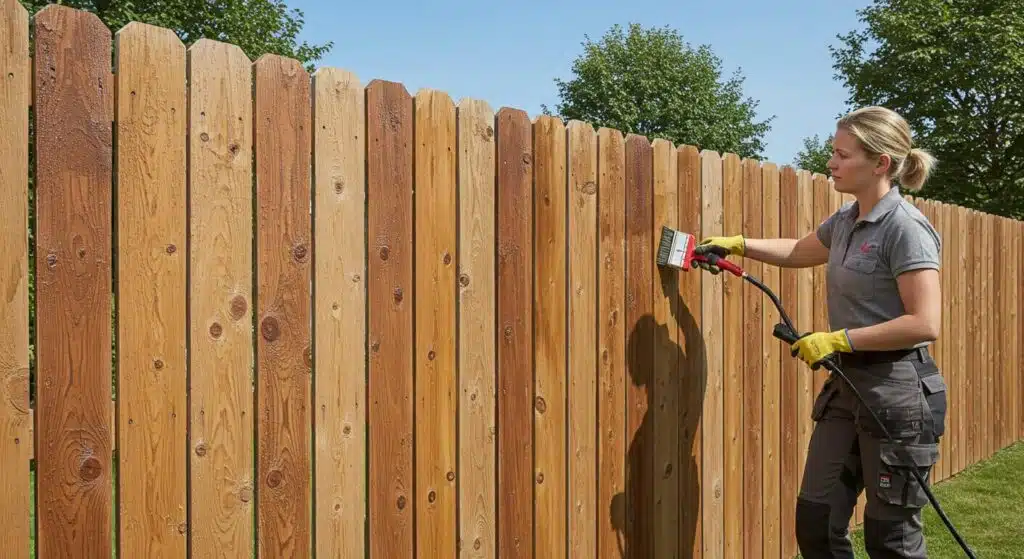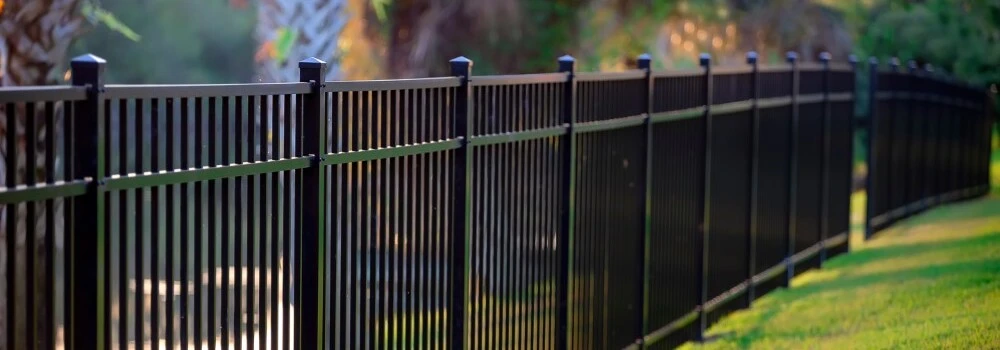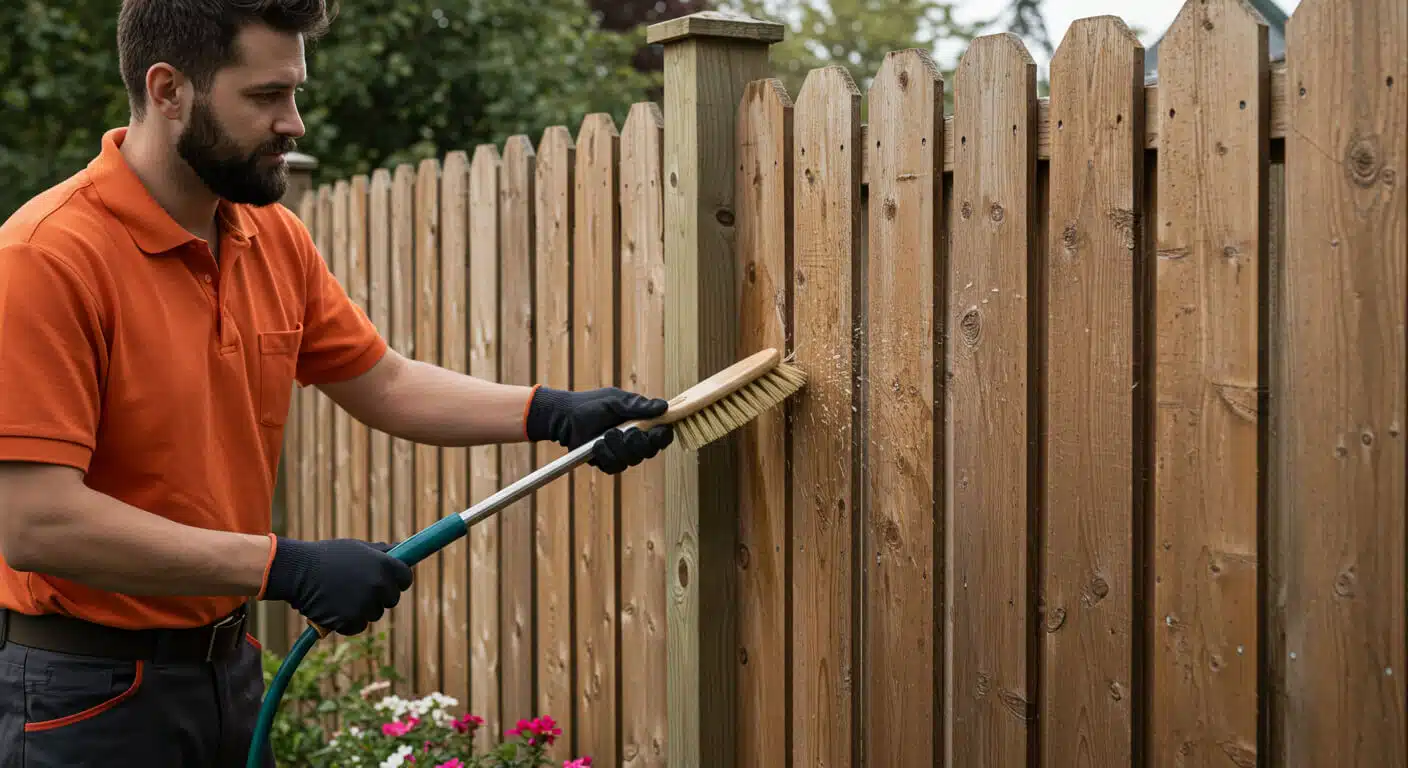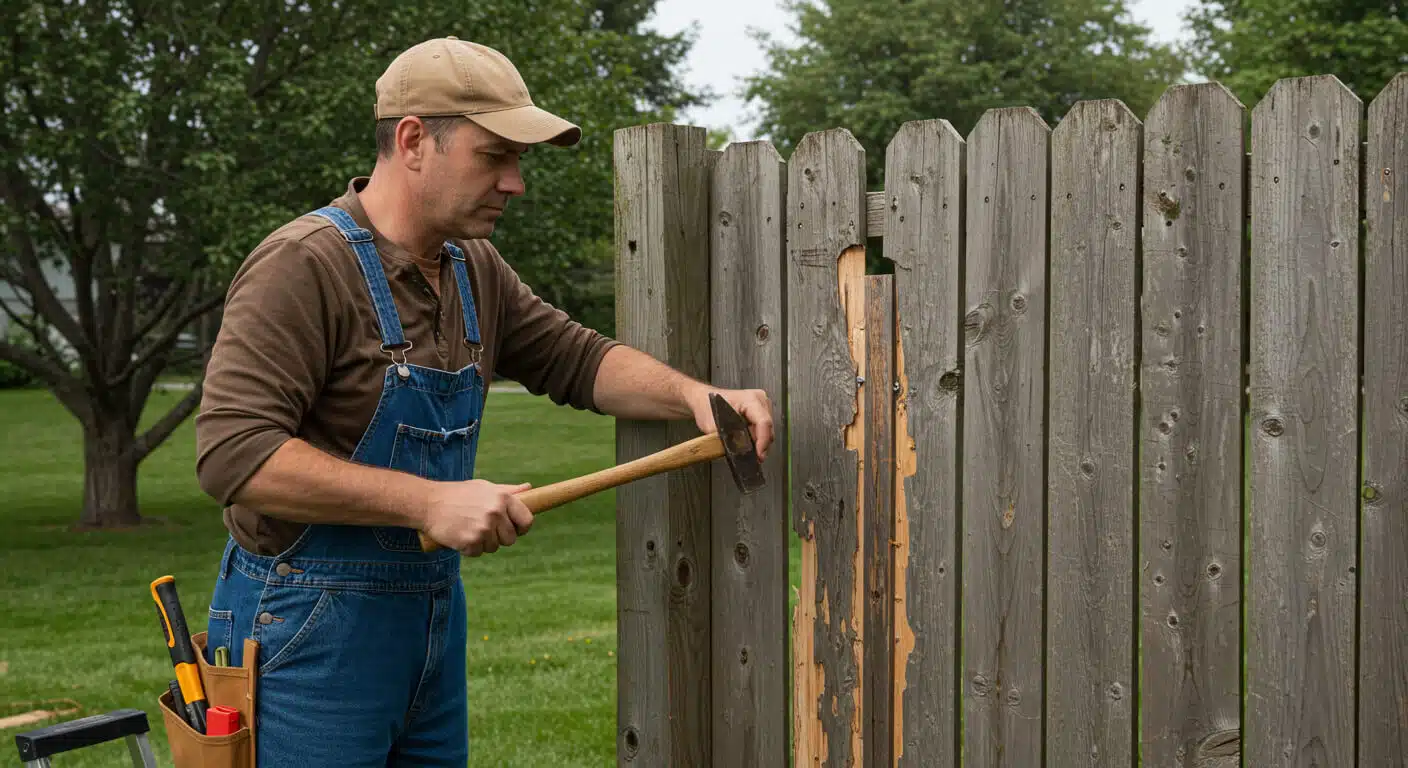
13 Key Wood Fence Maintenance Tips Every Homeowner Should Know
A beautiful wood fence can enhance your home’s curb appeal—but only if it’s well-maintained.
Knowing the right wood fence maintenance tips is essential to keeping your fence looking great and standing strong for years. From Atlanta’s humidity to seasonal weather swings, local conditions can damage wood fences that aren’t cared for properly.
At Bravo Fence, we’ve seen how simple upkeep can make all the difference, and we’re here to help you protect your investment with expert advice and support.
In this blog, you will learn:
- Why caring for your wood fence extends its life and beauty
- 13 practical maintenance tips—from cleaning to inspections
- How timely fixes can prevent costly repairs down the road
Let’s dive into the essential steps every homeowner needs to know for a fence that continues to impress and endure.
13 Essential Wood Fence Maintenance Tips for Atlanta Homeowners
Maintenance of your wood fence is crucial if you want your fencing to last and look good.
In Atlanta, homeowners who choose the right care can get a lot from it, whether the fence is new or has been there for some time. The wood type and how much the fence gets exposed to the weather make a big difference in how you care for it.
You should keep the fence line clean to keep it in good shape. Adding protective coats and fixing any damage early is key. These steps help keep your fence strong and looking great. We will look at tips to help you have a long fence that lasts and maintains its natural beauty.
1. Regularly inspecting and repairing damaged areas
Taking care of your fence starts with regular checks for signs of wear.
Look for cracks, splinters, or boards that do not line up right. These minor problems can hurt the structural integrity of your fence as time goes on. You should walk along the fence line two times a year. Check every part, even spots that are not easy to see.
Do not ignore small repairs. Make sure to tighten any loose screws and replace broken boards. Add support to weak spots so that your fence stays in place. Pay extra attention to spots where the boards join because these can show signs of deterioration first. Fixing these problems right away prevents bigger issues and saves you time and money in the long run.
If you have both wooden and chain link fencing on your property, check each kind for rust or other signs of wear. Use the right tools and steps to fix problems to keep your fence’s strength and longevity. If you stay on top of problems, your fence will keep your space safe for many years.
Next, we will look at cleaning. Good cleaning makes your fence look good and helps it stay strong.
2. Keeping the fence clean and free from debris
Keeping your wood fence clean helps prevent grime and mildew from building up, which can weaken the fence. Use a garden hose with a spray nozzle to rinse off dirt and dust. Do this often. Regular rinsing keeps your fence looking nice and helps maintain its natural beauty.
If you see tougher dirt or stains, use a soft brush with some gentle soap or a mild detergent. Do not use anything rough that could scratch the wood. Work on the tough spots with the brush, but rinse well with the hose when you finish. This step protects the wood from damage.
Pay close attention after storms or yard work. Pick up leaves, branches, or junk that might have fallen on or near your fence. If these stay, they keep in moisture, which can lead to rot.
Once everything is clean, your fence will shine and be ready for the next step in good fence maintenance: adding protective coatings.
3. Applying a protective sealant or stain
A good sealant or stain protects your fence from water damage, the sun, and everyday wear.
Choose the one made for your wood type and the climate in your area. You need to start by cleaning the fence well, then let it dry. After that, you can put on the sealant or stain so you get the best results.
Put on a new coat of sealant every two to three years. This stops cracks or warping that can happen with rain or sun. Stains give rich color and still let the wood grain show while keeping the fence safe. Use a roller, sprayer, or brush to cover all parts evenly. Pick what works best for the space you need to cover.
When cleaning and applying the coating, always follow the manufacturer’s instructions and check the weather. Don’t do this job when it’s raining or really humid. When the fence is well-treated, it will look good and be tough for many years.
As you will see in the next steps, cutting back any nearby vegetation will help protect your fence even more.
4. Trimming nearby vegetation to prevent damage
Unchecked vegetation, like vines and bushes, can push up against your fence line. This can trap moisture and cause decay. To keep your fence in good shape, cut back plants often. Use pruning tools to trim any growth close to your fence. This also allows airflow, so mildew and mold do not have a chance to build up.
Fast-growing vines may stick to your fence and make wear happen even faster. Pull these off quickly to stop damage. Also, trim any branches that hang over, since they can fall and dent the fence. By keeping up with regular upkeep, you help your fence last longer.
If you want to landscape near your fence, consider placing plants far enough away from the fence line. This will help you have a clear area around your fence and make maintenance easier in the future. Try to be steady with these steps to stop surprise repairs.
When cutting back vegetation around your fence, look for signs of insect problems—our next tip will cover that.
5. Checking for signs of insect infestations
Pests like termites or carpenter ants can be a big problem for your wood fence’s longevity.
If you want your fence to last, you should check it often for any insect damage. Look for things like tiny holes, dry bits of insect leftovers called frass, or wood that feels soft or weak. Use a flashlight to look at dark spots on the fence because these areas often get rot or decay first.
To keep pests away, treat the fence with insect-repellent preservatives. You can also use pressure-treated wood, which naturally stops termites and other pests from moving in. Try to cut back plants near the fence to remove places where insects might hide. If you keep the grass trimmed along the fence line, you will also help keep moisture away, which pests like too.
If you are a homeowner and you see a lot of damage, you should call a pest control professional. When you act fast, you can stop the problem from getting worse. By watching over your wood fence and treating it correctly, you will lower the risks and help your fence stay strong.
It is also important to ensure that your fence posts are stable, and I will discuss that next.
6. Addressing any warping or shifting of the fence posts
Fence posts are very important for your wooden fence.
They help keep it strong and upright. But the soil can move over time, and the posts can take in moisture, too. This often causes warping or the posts to move. If you catch this early, you can prevent bigger issues from happening.
Check your fence posts often. Try rocking them a bit. This will help you see if they feel loose or if there is any sign of deterioration. Replace any posts that show a lot of damage to keep the structural integrity of your fence. If you find a post that has shifted, use stabilizing concrete to hold it in place. This makes it strong against big winds or erosion from water.
Small fixes, like making brackets tighter or adding stabilizing screws, can keep your fence line looking good too. Pay extra attention to posts near tight soil or areas where water sits. The base of the fence needs to be looked after, so your whole fence stays upright and even.
Once you know your posts are firm, the next step is to watch for damage from lawn equipment that you store nearby.
7. Properly storing lawn equipment and avoiding hitting the fence
Misplaced lawn equipment can accidentally hurt your wood fence, so keeping it at a safe distance is good. If you keep tractors, edgers, or other tools too close, they can scratch the fence or may affect your fence maintenance tips.
Be careful around the fence line when mowing or using any machine. If you hit the fence by mistake, the metal hardware might bend, or you might dent soft areas of the wood. Try to keep your equipment in certain places away from the fencing.
Check your storage options, so rusty or loose tools don’t harm your fence. Use a tarp or an enclosed shed to help with durability and keep things in order. Controlling where your equipment goes will help the fence stay strong.
Now, in the next part, you will learn how the weather can impact the shape and life of fences.
8. Protecting the wood from moisture and weather elements
Long-term contact with moisture, UV rays, and changing weather weakens wood.
To protect your fence, make sure you have good drainage. This helps stop water damage at the bottom. Be ready to use the sealant right away if you spot any moisture. Sealant works well to coat and shield the surface.
During wet months, look for water gathering around the posts. You can move sprinklers to reduce wet spots that can make the wood soft. It’s essential to seal spots where UV rays hit the most in dry places. This stops color change or cracking.
Use post caps to cover exposed surfaces from the weather and keep your fence looking good. Regular weatherproofing and upkeep keep the wood strong and help it last longer.
Looking after your hardware matters, too, as does guarding against bad weather. You will see more on this in the next part.
9. Checking for loose or rusted hardware and replacing as needed
Loose or rusted hardware can make your fence less steady.
Hinge screws, nails, or bolts should be checked from time to time. You need to change or fix them to keep everything safe. If you do not make these small repairs, the fence might worsen.
Look at how the pickets, posts, and gates connect. For iron fences or other metals, clean away rust with a wire brush. If the damage from rust is too great and affects the fence’s function, then it is best to replace those metal parts. Hardware is important for your fence’s longevity.
If you see problems you cannot fix by swapping out parts, you may want to ask experts for help. They can make sure the base of your fence does not get weak. When you put in new hardware, your fence works as it should. It also becomes stronger in every part.
Taking care of the hardware on your fence helps add years to its use and keeps up its durability. Stay alert with small repairs, and you will keep mildew away, which is coming up next.
10. Regularly cleaning and treating mildew or mold growth
Mildew and mold grow fast in places with high humidity or where a fence stays shaded.
They can ruin the look and strength of your wooden fence. To clean mildew, mix bleach with water. Use a soft brush to scrub at the spots gently. After you use the brush, rinse the area well with a garden hose so all the cleaning leftovers are gone.
If you see mold near plants or in damp spots, take care of those areas first. Spray on sealers to keep out moisture and help stop the problem from coming back. If you clean the fence often, you get rid of most fungus and help your wooden fence look good all the time.
It is a good idea to clean stained spots after rain or storms. This helps prevent mold from growing over time. Fences that get the right care last longer since mildew can’t hurt them as much.
Don’t use harsh chemicals to clean because they can damage the finish and beauty of your fence. The next part will tell you more about that.
11. Avoid using harsh chemicals on the fence
Harsh chemical cleaners can damage the outside of your wood fence.
They take away its protective layer. This makes the fence open to things like deterioration and decay. It’s better to use natural cleaning solutions, like ones with vinegar. These are gentle and clean off dirt, but keep the fence’s natural beauty.
For tough stains and mildew, you will see better results with special cleaners made for wood. Strong chemical products are not needed. You can also mix mild detergent with water. This is kind to the fence and helps remove grime while keeping the wood in good shape.
Proper fence maintenance includes keeping the wood’s surface safe. This helps the fence last a long time and maintain its durability. Always choose products that are safe for outdoor fencing and clearly state this. Don’t use corrosive products.
While chemical-free cleaning is good for your fence, you should also watch the wood for signs of rot or breakdown.
Doing all this will ensure your fence stays strong and looks good.
12. Monitoring for signs of rot or decay in the wood
Keeping a regular check on your wood fence helps you spot any rot or decay early.
These problems can make it look bad and not work well. Look out for dark spots, soft areas, or a musty smell. These all signal that there may be trouble. Inspect important parts like the posts and corners, as that is where moisture often collects.
If you have pressure-treated wood, it will help fight off some deterioration. But if your fence is not treated, add extra preservative to it to keep it safe. If the decay has already hit bigger spots, you must replace those boards. When you fix small issues fast, you stop them from taking over other panels.
If your fence receives a lot of rain or experiences a lot of humidity, look for water marks or places where it sags. These signs show that rot may have penetrated the wood. Fixing problem areas right away helps keep your fence strong as the seasons change, but sometimes problems still happen.
If so, hire a pro like Bravo to solve large trouble spots.
13. Seeking professional help for major repairs or replacements.
Homeowners need to know that doing it yourself is not always the best choice, especially if there is significant damage to a wood fence.
Our experts have the right skills to check problems caused by rot, insect damage, or bad weather. Getting help from our professionals is a good way to ensure the structural integrity of your fence.
We can help your fence last longer by making the right fixes or replacements. When you trust someone with a lot of experience, you keep the wood’s natural beauty and durability. Ultimately, this will get you the best results for your fencing and protect your investment for many years.
Keep Your Fence Standing Tall with Bravo Fence
Caring for your fence doesn’t have to be complicated, but it does have to be consistent. These 13 wood fence maintenance tips are simple yet powerful ways to protect your fence from wear, weather, pests, and time.
Whether you’re cleaning off mildew, sealing the wood, or checking for loose posts, every small action adds up to a fence that lasts longer and looks better. In a climate like Atlanta’s, preventive maintenance is the key to preserving the beauty and durability of your investment.
At Bravo Fence, we believe that the right guidance and a little effort can help your wood fence stay strong for years to come. If you ever feel unsure about a repair or want expert help maintaining your fence, we’re just a call away.
Call us today at (770) 966-9970 or fill out our online form to schedule a free consultation. Your fence—and your peace of mind—are worth it.
Frequently Asked Questions
What type of wood is best for fences in Atlanta, Georgia?
If you live in Atlanta, you will want a fence that lasts. Good wood types for this are cedar, redwood, or pressure-treated pine. Cedar and redwood both have natural resistance to rot and insects. Pine is another option if you treat it correctly, and it is not expensive. With these wood types, you get durable fences that will stand up well over time.
How often should I reseal or restain my wood fence?
Reseal or restain your fence once every 2 to 3 years to get the best results. Watch for fading or excessive dryness. When water does not bead up on the fence anymore, it is time for a new coat. Doing these things often will help your fence’s lifespan, especially if there is bad weather.
How do I prevent termites and pests from damaging my fence?
Use wood preservatives or pressure-treated wood to protect your wood from termites and other pests. Be sure to put insect-repellent coatings on parts that are at risk. Trim any vegetation close to your wood to help stop insect damage and rot. Try to keep the area around your wood neat and clean for the best protection against problems like insect damage or rot.
Can I repair small holes or cracks myself, or should I call a professional?
You can do small repairs yourself, like filling in holes or swapping out boards, as long as your fence’s structural integrity is good. But if you see the damage getting worse or there are many signs of wear, it is best to get a professional. They can help you find the right fix.
What types of treatments are recommended for preserving a wood fence?
Recommended treatments for wood are sealants, stains, and natural preservatives. These help keep out moisture, protect against UV rays, and stop insects. Semi-transparent stains show off the wood grain. Durable paints give more protection against water damage and decay.



